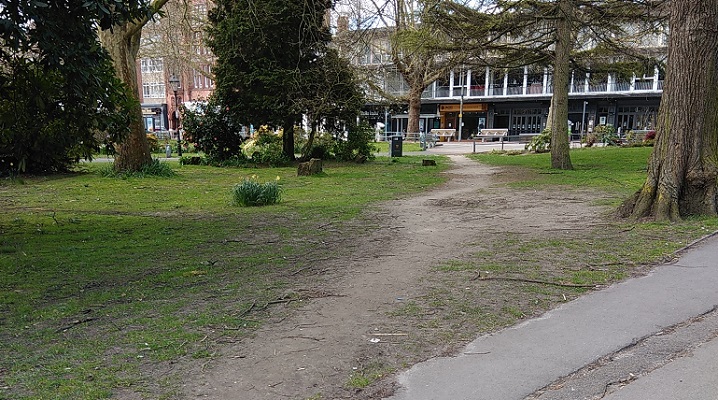Desire Lines
Desire lines in Central Parks

What is a desire line?
A desire line, or “walk-off” is a mud path worn away across a grassed area (although they do occur across shrub beds too), in parks and open spaces. Changes in use or new developments in the surrounding built environment create changes in the direction and volume of foot and cycle traffic across the park.
Why not just leave them?
Apart from looking unsightly, soil compaction is also a problem. It can damage trees when over their root system. Compacted ground is prone to surface flooding. Walk-off paths attract a number of complaints and SCC have been claimed against for slips and trips on these paths, as soil erodes and subterranean stones are exposed creating a trip hazard. They are also muddy and therefore slippery in the winter. There is already a fairly comprehensive path network through the parks and pavements around them. These desire lines are short cuts and, in all cases, sticking to the existing path system would only add a negligible amount of time to the journey. Guiding people towards using the existing path network to protect the parks would impose an insignificant inconvenience to park users.
Why not just formalise them with more macadam paths?
The danger of formalising each desire line as it forms is the creation of an unintended “Union Jack” design on each park, but even this might not be enough and corners and minor short-cuts are made within this formation. The result is the loss of green open space to a spider’s web of macadam paths. Some are transient and fall into disuse if a particular shop or other destination closes and the draw is halted. Others are more permanent and are a response to changes in the surrounding highways or educational facilities. These need to be managed by balancing the need to protect the access to greenspace for everyone, and the convenience of the people crossing it.
Designations and restrictions
Central Parks are registered Common Land, which gives them added legal protection. Incremental loss of access to green open space has been recognised, so, to protect this, the ratio between hard landscape (paths, paving, hard courts etc.) and the soft landscape (grass, shrubs etc.) must remain the same. Any changes to the Common Land which might alter this ratio, the addition of fences or other changes to access will require a “Section 38” application to the Planning Inspectorate, with no guarantee of gaining permission. Laying a macadam path over a grassed area would be seen as a “loss of access to green open space”.
Central Parks are registered by Historic England as “Grade 2 star”. One of the primary reasons for this listing is for the preservation of the parks original layout from the mid-19th Century. The Parks are also the setting for a number of Listed Monuments. Historic England are top of the list of required consultees when submitting a Section 38 application
What are the options?
There are three options for every instance of walk-off. These are:
- Do nothing. This might be an option in situations where the desire line leads to a business. Over time, businesses move, open and close so it could be a temporary problem and so does not demand a permanent solution. This might change if the situation persists more than two or three years.
- Formalise the path. This would be the choice of all the people who create and contribute to the short-cuts but isn’t necessarily the best option for the park’s integrity for reasons mentioned above. However, where wear is so bad, for an extended period of time this might have to be an option. When considering this, it is important to respect the original historic layout and the health and wellbeing of the trees, shrubs and grass. All vegetation removes carbon dioxide and other airborne pollutants from the air. All other surfaces do not.
- Fit knee rails. Knee rails are a low fence or rail (50 – 60cm), which doesn’t interfere with sight-lines across the park, but guides footfall onto the existing pavements and paths. People can step over them, but experience has shown us that if all cycling and most of the footfall can be redirected, the grass can cope with what remains if the legacy issues of compaction are resolved. This protects the living material in the parks, allowing it to deliver the eco-services we all rely on for cleaner air.
Current issues and recommendations
- Central Parks walk off
- East Park North walk off
- East Park walk off
- Palmerston Park walk off
- West Park walk off
If you would like to comment on these proposals, or would like further information, please email parksandstreetcleansing.services@southampton.gov.uk. Closing date for comments 25 September 2020

